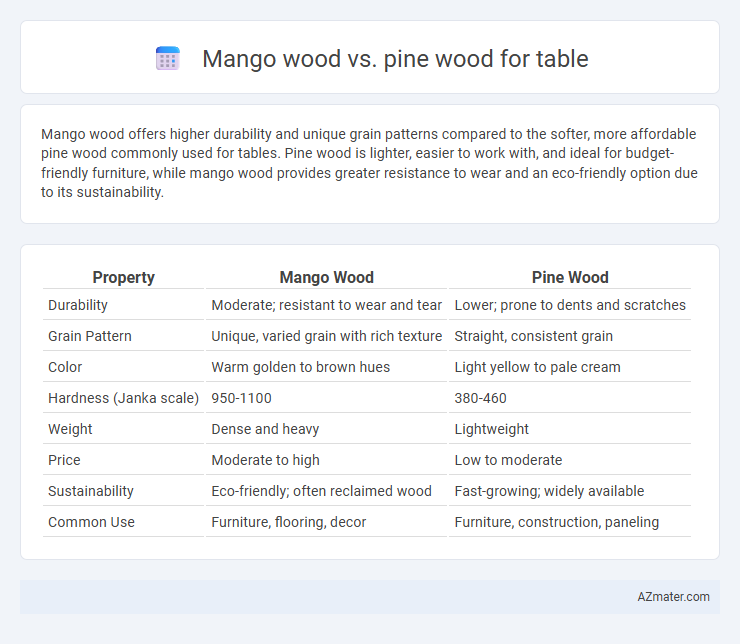Mango wood offers higher durability and unique grain patterns compared to the softer, more affordable pine wood commonly used for tables. Pine wood is lighter, easier to work with, and ideal for budget-friendly furniture, while mango wood provides greater resistance to wear and an eco-friendly option due to its sustainability.
Table of Comparison
| Property | Mango Wood | Pine Wood |
|---|---|---|
| Durability | Moderate; resistant to wear and tear | Lower; prone to dents and scratches |
| Grain Pattern | Unique, varied grain with rich texture | Straight, consistent grain |
| Color | Warm golden to brown hues | Light yellow to pale cream |
| Hardness (Janka scale) | 950-1100 | 380-460 |
| Weight | Dense and heavy | Lightweight |
| Price | Moderate to high | Low to moderate |
| Sustainability | Eco-friendly; often reclaimed wood | Fast-growing; widely available |
| Common Use | Furniture, flooring, decor | Furniture, construction, paneling |
Introduction to Mango Wood and Pine Wood
Mango wood, derived from the fast-growing mango tree, is prized for its durability, unique grain patterns, and eco-friendly nature, making it a popular choice for sustainable furniture like tables. Pine wood, sourced from several species of pine trees, is known for its light color, affordability, and ease of workability, often used in rustic or casual table designs. Both woods offer distinct aesthetics and functional properties suited to different table styles and preferences.
Key Characteristics of Mango Wood
Mango wood is dense and durable, making it highly resistant to wear and ideal for tabletops that endure daily use. Its unique grain pattern and warm, golden-brown color enhance the aesthetic appeal, providing a rich and natural look. Unlike pine wood, mango wood offers greater hardness and stability, reducing the likelihood of dents and scratches over time.
Key Characteristics of Pine Wood
Pine wood is a softwood known for its light color, straight grain, and affordability, making it a popular choice for tables that emphasize a rustic, natural look. It has a relatively low density, which contributes to its lightweight nature but can lead to higher susceptibility to dents and scratches compared to hardwoods. Pine's excellent workability and ability to take stains well allow for versatile finishes, though its softness may require protective coatings for enhanced durability in table surfaces.
Durability: Mango Wood vs Pine Wood
Mango wood offers superior durability compared to pine wood due to its dense grain structure and natural resistance to wear and tear, making it ideal for long-lasting tables. Pine wood is softer and more prone to dents and scratches, requiring more maintenance to preserve its appearance over time. Tables crafted from mango wood often withstand heavy use and environmental changes better than those made from pine.
Appearance and Grain Comparison
Mango wood boasts a rich, golden-brown hue with unique, irregular grain patterns that create a warm, rustic appearance, ideal for statement tables. Pine wood features a lighter, creamy-yellow tone with straight, uniform grain lines, offering a more traditional and casual look for furniture. The contrasting grain complexity means mango wood tables often exhibit more character and visual interest compared to the simpler, softer texture of pine wood tables.
Sustainability and Eco-Friendliness
Mango wood is a highly sustainable choice for tables as it is sourced from harvested mango trees that no longer produce fruit, reducing deforestation and waste. Pine wood, while renewable, often involves faster growth cycles and can contribute to monoculture practices that impact biodiversity. Mango wood's dense fibers and natural resistance to pests decrease the need for chemical treatments, enhancing its eco-friendliness compared to pine.
Cost and Affordability Analysis
Mango wood tables generally cost more due to their durability and rich grain patterns, making them a mid-range option for buyers seeking long-lasting furniture with unique aesthetics. Pine wood offers a more affordable alternative, with lower prices attributed to its faster growth rate and easier availability, but it tends to be softer and less resistant to dents and scratches. When evaluating cost and affordability, pine wood suits budget-conscious consumers, whereas mango wood is preferred for those prioritizing a balance between cost and premium quality.
Maintenance and Care Requirements
Mango wood requires regular oiling and polishing to maintain its durability and rich appearance, as it is prone to drying and cracking without proper care. Pine wood, being softer and more porous, demands frequent cleaning and protective coatings to prevent dents, scratches, and moisture damage. Both woods benefit from avoiding prolonged exposure to direct sunlight and humidity to preserve their structural integrity and aesthetic appeal.
Best Uses: Mango Wood vs Pine Wood Tables
Mango wood tables offer exceptional durability and resistance to scratches and moisture, making them ideal for dining tables and outdoor furniture that require long-lasting strength. Pine wood tables, characterized by their lightweight and soft texture, are best suited for occasional or decorative pieces such as coffee tables and side tables where affordability and ease of customization matter. The dense grain of mango wood supports intricate carving and heavy use, while pine wood's porous structure allows for easier staining but less resistance to dents and wear.
Final Verdict: Which Wood is Better for Tables?
Mango wood offers superior durability and a rich, distinctive grain that enhances the aesthetic appeal of tables, making it ideal for long-lasting furniture. Pine wood is softer, more affordable, and easier to work with but is prone to dents and scratches, which reduces its longevity for high-traffic table surfaces. Considering strength, visual appeal, and lifespan, mango wood is the better choice for high-quality, durable tables.

Infographic: Mango wood vs Pine wood for Table
 azmater.com
azmater.com